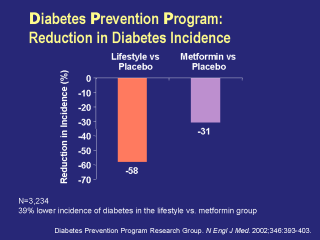| front |1 |2 |3 |4 |5 |6 |7 |8 |9 |10 |11 |12 |13 |14 |15 |16 |17 |18 |19 |20 |21 |22 |23 |24 |25 |26 |27 |28 |29 |30 |31 |32 |33 |34 |35 |36 |37 |38 |39 |40 |41 |42 |43 |44 |45 |46 |47 |48 |49 |review |
 |
Lifestyle reduced the incidence of diabetes by
58% (95% CI, 48%-66%) and metformin reduced the incidence by 31% (95%
CI, 17%-43%). The incidence of diabetes was 39% lower (95% CI, 24%-51%) in the lifestyle group than in the metformin group. Treatment effects did not differ significantly according to sex or to race or ethnic group. The lifestyle intervention was highly effective in all subgroups. Its effect was significantly greater among persons with lower base-line glucose concentrations two hours after a glucose load than among those with higher base-line glucose values. The advantage of lifestyle intervention over metformin was greater in older persons and those with a lower body-mass-index than in younger persons and those with a higher body-mass-index. The effect of metformin was less with a lower body-mass-index or a lower fasting glucose concentration than with higher values for those variables. The investigators concluded that, compared with placebo, 1 case of diabetes can be prevented for every 7 persons treated with lifestyle changes for 3 years and for every 14 persons treated with metformin for 3 years. Diabetes Prevention Program Research Group. N Engl J Med. 2002;346:393-403. |